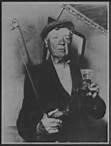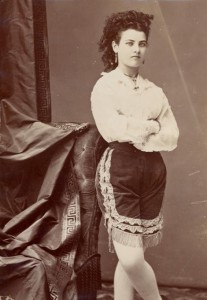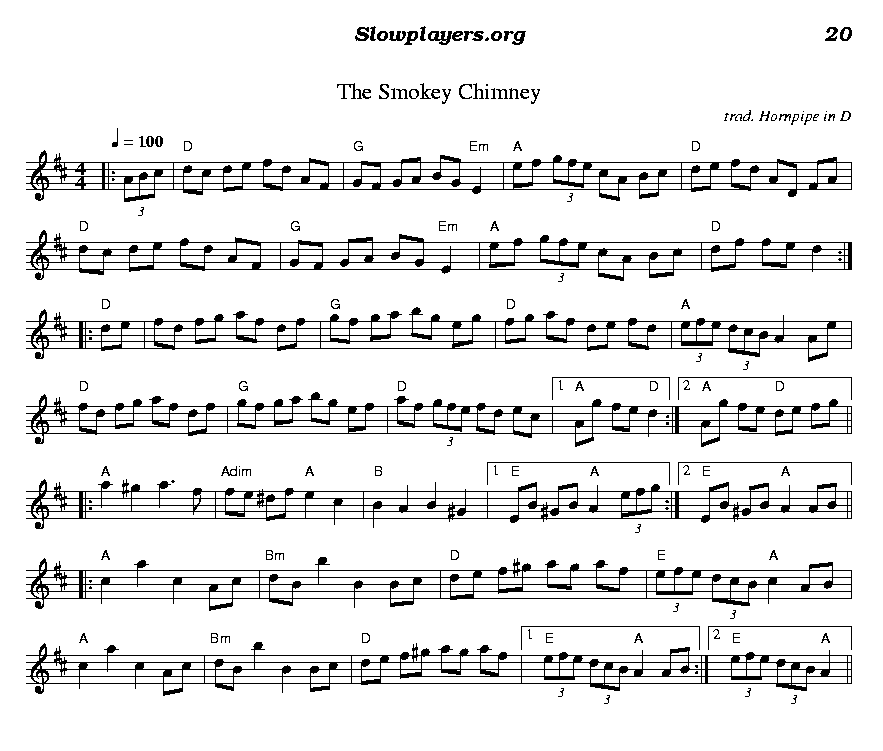
Padraig O’Keefe
“The Smokey Chimney” is a strange little hornpipe, a fact which makes me like it even more. It is in two keys, and so seemslike some kind of hornpipe mash-up — which it is. It is tune #1635 in O’Neill’s 1850 (i.e., O’Neill’s Music of Ireland, 1903) as a two part tune, the first two parts listed here. It can be played that way too, of course, as it used to be played over a century ago. So, you may ask, how did it come to be an odd little three-and-a-half part tune? Well, some say that on one cold, dark wintery night the Sliabh Luachra fiddler Padraig O’Keeffe (1887-1963) added the other parts. Now he was a man often found at Jack Lyon’s pub in Scartaglen, and was well-known to be partial to tunes with more than two parts. Jack Lyon had, it seems, received some phonographic records from those distant United States, and had been listening to them.

Carte de visite of Kitty O’Neil, sand dancer, 1877
One tune he liked was called “Kitty O’Neil” after the renowned sand-dancer, often called “the first American clog dancer,” Catherine Connolly (1852?-1893) who changed her name to Kitty O’Neil at the request of the New York and Boston theater producers Tony Pastor and Ned Harrigan. The recording was, perhaps, of the New Hampshire fiddler John Taggart (1854-1943), who wrote that most of the tunes he knew “were all taught me during my boyhood days in Sharon [New Hampshire] by the various fiddlers in that vicinity,” some of whom could well have visited Boston, Pittsburgh, New York, or Brooklyn and picked up tunes from shows where Kitty O’Neil performed her “fancy dances.” The tune now called “Kitty O’Neil” was also known as “The Sand Dance” and is printed in White’s Unique Collection of Jigs, Reels, etc.: Arranged for Violin with Piano Accompaniment, vol. 2 (Boston: White-Smith, 1902). That tune is also called the “Sand Jig” – though it’s not a jig – due to the fact that in the late nineteenth century a “sand jig” referred not to an Irish dance, but to a syncopated dance performed in hard-soled shoes where instead of tapping, the dancer would scrape and shuffle her feet on a sand-strewn stage. In terms of pulse and tempo the sand dance is something close to a schottische, or German, or banrdance, a syncopated tune in 2/4 or 4/4 tempo. While almost forgotten, the sand dance does appear performed by Fred Astaire in the film Top Hat (1935).
Anyway, the American record was played and enjoyed by Jack Lyon, and being a regular there Padraig O’Keeffe took it upon himself to simply borrow that American “sand dance” tune now called “Kitty O’Neil” and graft it to the end of the existing tune “The Smoky Chimney.” He did, and the result is an old-fashioned Irish-American mash-up played by only the select few. I am not, at this point, going to go into more detail or to expand this discussion to include the seven-part dance/tune entitled “Kitty O’Neil’s Champion Jig” — the Riverdance of its day — which was confusingly shortened to just “Kitty O’Shea” on the Tommy Peoples and Daithi Sproule LP The Iron Man (1972), as track #12, and which was re-released as the CD The Iron Man (1995) without the original first track.
If you want the ABC just click Smokey Chimney
Smokey Chimney, slow tempo
Smokey Chimney, med tempo
Smokey Chimney, the dots

Smokey Chimney Hornpipe
Like this:
Like Loading...
Related
Smokey Chimney (D|A)
Padraig O’Keefe
“The Smokey Chimney” is a strange little hornpipe, a fact which makes me like it even more. It is in two keys, and so seemslike some kind of hornpipe mash-up — which it is. It is tune #1635 in O’Neill’s 1850 (i.e., O’Neill’s Music of Ireland, 1903) as a two part tune, the first two parts listed here. It can be played that way too, of course, as it used to be played over a century ago. So, you may ask, how did it come to be an odd little three-and-a-half part tune? Well, some say that on one cold, dark wintery night the Sliabh Luachra fiddler Padraig O’Keeffe (1887-1963) added the other parts. Now he was a man often found at Jack Lyon’s pub in Scartaglen, and was well-known to be partial to tunes with more than two parts. Jack Lyon had, it seems, received some phonographic records from those distant United States, and had been listening to them.
Carte de visite of Kitty O’Neil, sand dancer, 1877
One tune he liked was called “Kitty O’Neil” after the renowned sand-dancer, often called “the first American clog dancer,” Catherine Connolly (1852?-1893) who changed her name to Kitty O’Neil at the request of the New York and Boston theater producers Tony Pastor and Ned Harrigan. The recording was, perhaps, of the New Hampshire fiddler John Taggart (1854-1943), who wrote that most of the tunes he knew “were all taught me during my boyhood days in Sharon [New Hampshire] by the various fiddlers in that vicinity,” some of whom could well have visited Boston, Pittsburgh, New York, or Brooklyn and picked up tunes from shows where Kitty O’Neil performed her “fancy dances.” The tune now called “Kitty O’Neil” was also known as “The Sand Dance” and is printed in White’s Unique Collection of Jigs, Reels, etc.: Arranged for Violin with Piano Accompaniment, vol. 2 (Boston: White-Smith, 1902). That tune is also called the “Sand Jig” – though it’s not a jig – due to the fact that in the late nineteenth century a “sand jig” referred not to an Irish dance, but to a syncopated dance performed in hard-soled shoes where instead of tapping, the dancer would scrape and shuffle her feet on a sand-strewn stage. In terms of pulse and tempo the sand dance is something close to a schottische, or German, or banrdance, a syncopated tune in 2/4 or 4/4 tempo. While almost forgotten, the sand dance does appear performed by Fred Astaire in the film Top Hat (1935).
Anyway, the American record was played and enjoyed by Jack Lyon, and being a regular there Padraig O’Keeffe took it upon himself to simply borrow that American “sand dance” tune now called “Kitty O’Neil” and graft it to the end of the existing tune “The Smoky Chimney.” He did, and the result is an old-fashioned Irish-American mash-up played by only the select few. I am not, at this point, going to go into more detail or to expand this discussion to include the seven-part dance/tune entitled “Kitty O’Neil’s Champion Jig” — the Riverdance of its day — which was confusingly shortened to just “Kitty O’Shea” on the Tommy Peoples and Daithi Sproule LP The Iron Man (1972), as track #12, and which was re-released as the CD The Iron Man (1995) without the original first track.
If you want the ABC just click Smokey Chimney
Smokey Chimney, slow tempo
Smokey Chimney, med tempo
Smokey Chimney, the dots
Smokey Chimney Hornpipe
Like this:
Related